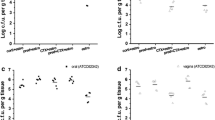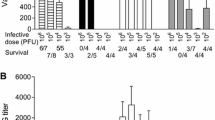Abstract
The animal models available for studying the immune response to genital tract infection require induction of a pseudo estrous state, usually achieved by administration of 17-β-estradiol. In our experimental model of vaginal candidiasis, under pseudo estrus, different strains of mice were used. We observed major differences in the clearance of Candida albicans infection among the different strains, ascribable to differing susceptibility to estradiol treatment. In the early phase of infection CD1, BALB/c, C57BL/6 albino and C57BL/6 mice were colonized to similar levels, while in the late phase of infection, BALB/c mice, which are considered genetically resistant to C. albicans infection, exhibited greater susceptibility to vaginal candidiasis than CD1 and C57BL/6 albino strains of mice. This was because estradiol induced “per se” enlarged and fluid-filled uteri, more pronounced in infected mice and consistently more evident in BALB/c and C57BL/6 mice than in CD1 mice. Unlike CD1, BALB/c and C57BL/6 mice showed a heavy fungal colonization of the uterus, even though C57BL/6 mice apparently cleared C. albicans from the vagina. The presence of C. albicans in the vagina and uterus was accompanied by a heavy bacterial load. Collectively these observations prompted us to carry out a careful analysis of estradiol effects in a mouse model of vaginal infection.






Similar content being viewed by others
References
Sobel JD. Vulvovaginal candidosis. Lancet. 2007;369(9577):1961–71. doi:10.1016/S0140-6736(07)60917-9.
Kennedy MA, Sobel JD. Vulvovaginal candidiasis caused by non-albicans candida species: new insights. Curr Infect Dis Rep. 2010;12(6):465–70. doi:10.1007/s11908-010-0137-9.
Dennerstein GJ, Ellis DH. Oestrogen, glycogen and vaginal candidiasis. Aust N Z J Obstet Gynaecol. 2001;41(3):326–8.
Naglik JR, Fidel PL Jr, Odds FC. Animal models of mucosal Candida infection. FEMS Microbiol Lett. 2008;283(2):129–39. doi:10.1111/j.1574-6968.2008.01160.x.
Dalal SJ, Estep JS, Valentin-Bon IE, Jerse AE. Standardization of the Whitten effect to induce susceptibility to Neisseria gonorrhoeae in female mice. Contemp Top Lab Anim Sci. 2001;40(2):13–7.
Yadav M, Gupta I, Malla N. Kinetics of immunoglobulin G, M, A and IgG subclass responses in experimental intravaginal trichomoniasis: prominence of IgG1 response. Parasite Immunol. 2005;27(12):461–7. doi:10.1111/j.1365-3024.2005.00800.x.
McGowin CL, Spagnuolo RA, Pyles RB. Mycoplasma genitalium rapidly disseminates to the upper reproductive tracts and knees of female mice following vaginal inoculation. Infect Immun. 2010;78(2):726–36. doi:10.1128/IAI.00840-09.
Cheng G, Yeater KM, Hoyer LL. Cellular and molecular biology of Candida albicans estrogen response. Eukaryot Cell. 2006;5(1):180–91. doi:10.1128/EC.5.1.180-191.2006.
Clemons KV, Spearow JL, Parmar R, Espiritu M, Stevens DA. Genetic susceptibility of mice to Candida albicans vaginitis correlates with host estrogen sensitivity. Infect Immun. 2004;72(8):4878–80. doi:10.1128/IAI.72.8.4878-4880.2004.
Spearow JL, O’Henley P, Doemeny P, Sera R, Leffler R, Sofos T, et al. Genetic variation in physiological sensitivity to estrogen in mice. APMIS. 2001;109(5):356–64.
Enjalbert B, Rachini A, Vediyappan G, Pietrella D, Spaccapelo R, Vecchiarelli A, et al. A multifunctional, synthetic Gaussia princeps luciferase reporter for live imaging of Candida albicans infections. Infect Immun. 2009;77(11):4847–58. doi:10.1128/IAI.00223-09.
Pietrella D, Angiolella L, Vavala E, Rachini A, Mondello F, Ragno R, et al. Beneficial effect of Mentha suaveolens essential oil in the treatment of vaginal candidiasis assessed by real-time monitoring of infection. BMC Complement Altern Med. 2011;11:18. doi:10.1186/1472-6882-11-18.
Pietrella D, Rachini A, Torosantucci A, Chiani P, Brown AJ, Bistoni F, et al. A beta-glucan-conjugate vaccine and anti-beta-glucan antibodies are effective against murine vaginal candidiasis as assessed by a novel in vivo imaging technique. Vaccine. 2010;28(7):1717–25. doi:10.1016/j.vaccine.2009.12.021.
Abdelwahab MG, Sankar T, Preul MC, Scheck AC. Intracranial implantation with subsequent 3D in vivo bioluminescent imaging of murine gliomas. J Vis Exp. 2011;57:e3403. doi:10.3791/3403
Ashman RB. Protective and pathologic immune responses against Candida albicans infection. Front Biosci. 2008;13:3334–51.
Ashman RB, Fulurija A, Papadimitriou JM. Strain-dependent differences in host response to Candida albicans infection in mice are related to organ susceptibility and infectious load. Infect Immun. 1996;64(5):1866–9.
Calderon L, Williams R, Martinez M, Clemons KV, Stevens DA. Genetic susceptibility to vaginal candidiasis. Med Mycol. 2003;41(2):143–7.
Packiam M, Veit SJ, Anderson DJ, Ingalls RR, Jerse AE. Mouse strain-dependent differences in susceptibility to Neisseria gonorrhoeae infection and induction of innate immune responses. Infect Immun. 2010;78(1):433–40. doi:10.1128/IAI.00711-09.
Murakami Y, Otsuki M, Kusumoto K, Takeuchi S, Takahashi S. Estrogen inhibits interleukin-18 mRNA expression in the mouse uterus. J Reprod Dev. 2005;51(5):639–47.
Otsuki M, Kusumoto K, Murakami Y, Kanayama M, Takeuchi S, Takahashi S. Expression of interleukin-18 receptor mRNA in the mouse endometrium. J Reprod Dev. 2007;53(1):59–68.
Fidel PL Jr, Cutright J, Steele C. Effects of reproductive hormones on experimental vaginal candidiasis. Infect Immun. 2000;68(2):651–7.
Styrt B, Sugarman B. Estrogens and infection. Rev Infect Dis. 1991;13(6):1139–50.
Salem ML. Estrogen, a double-edged sword: modulation of TH1- and TH2-mediated inflammations by differential regulation of TH1/TH2 cytokine production. Curr Drug Targets Inflamm Allergy. 2004;3(1):97–104.
Relloso M, Aragoneses-Fenoll L, Lasarte S, Bourgeois C, Romera G, Kuchler K, et al. Estradiol impairs the Th17 immune response against Candida albicans. J Leukoc Biol. 2012;91(1):159–65. doi:10.1189/jlb.1110645.
Straub RH. The complex role of estrogens in inflammation. Endocr Rev. 2007;28(5):521–74. doi:10.1210/er.2007-0001.
Seavey MM, Mosmann TR. Estradiol-induced vaginal mucus inhibits antigen penetration and CD8(+) T cell priming in response to intravaginal immunization. Vaccine. 2009;27(17):2342–9. doi:10.1016/j.vaccine.2009.02.025.
Taylor-Robinson D, Furr PM, Hetherington CM. Neisseria gonorrhoeae colonises the genital tract of oestradiol-treated germ-free female mice. Microb Pathog. 1990;9(5):369–73.
Jerse AE. Experimental gonococcal genital tract infection and opacity protein expression in estradiol-treated mice. Infect Immun. 1999;67(11):5699–708.
Song W, Condron S, Mocca BT, Veit SJ, Hill D, Abbas A, et al. Local and humoral immune responses against primary and repeat Neisseria gonorrhoeae genital tract infections of 17beta-estradiol-treated mice. Vaccine. 2008;26(45):5741–51. doi:10.1016/j.vaccine.2008.08.020.
Acknowledgments
This paper was supported by the Fondazione Cassa di Risparmio di Perugia, project number 2010.011.0398. We thank Catherine Macpherson for editorial assistance.
Conflict of interest
The authors declare there are no conflicts of interest.
Author information
Authors and Affiliations
Corresponding author
Additional information
Paolo Mosci and Donatella Pietrella contributed equally.
Rights and permissions
About this article
Cite this article
Mosci, P., Pietrella, D., Ricci, G. et al. Mouse Strain-Dependent Differences in Estrogen Sensitivity During Vaginal Candidiasis. Mycopathologia 175, 1–11 (2013). https://doi.org/10.1007/s11046-012-9589-9
Received:
Accepted:
Published:
Issue Date:
DOI: https://doi.org/10.1007/s11046-012-9589-9




